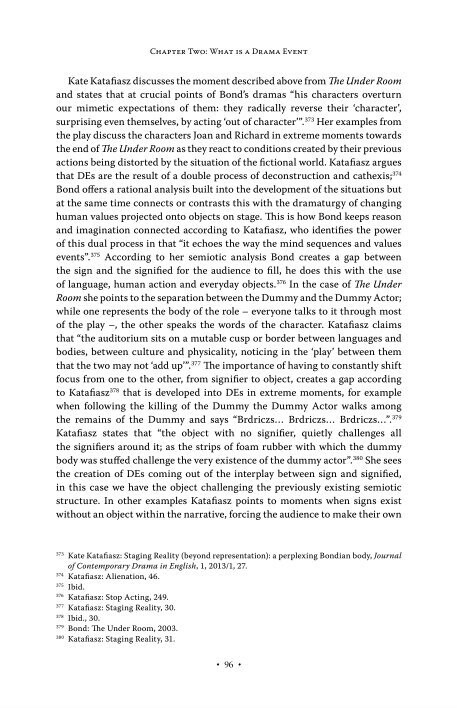

OCR
CHAPTER Two: WHAT Is A DRAMA EVENT Kate Katafiasz discusses the moment described above from The Under Room and states that at crucial points of Bond’s dramas “his characters overturn our mimetic expectations of them: they radically reverse their ‘character’, surprising even themselves, by acting ‘out of character”.*”* Her examples from the play discuss the characters Joan and Richard in extreme moments towards the end of The Under Room as they react to conditions created by their previous actions being distorted by the situation of the fictional world. Katafiasz argues that DEs are the result of a double process of deconstruction and cathexis;°”4 Bond offers a rational analysis built into the development of the situations but at the same time connects or contrasts this with the dramaturgy of changing human values projected onto objects on stage. This is how Bond keeps reason and imagination connected according to Katafiasz, who identifies the power of this dual process in that “it echoes the way the mind sequences and values events”.*” According to her semiotic analysis Bond creates a gap between the sign and the signified for the audience to fill, he does this with the use of language, human action and everyday objects.*” In the case of The Under Room she points to the separation between the Dummy and the Dummy Actor; while one represents the body of the role — everyone talks to it through most of the play —, the other speaks the words of the character. Katafiasz claims that “the auditorium sits on a mutable cusp or border between languages and bodies, between culture and physicality, noticing in the ‘play’ between them that the two may not ‘add up”. The importance of having to constantly shift focus from one to the other, from signifier to object, creates a gap according to Katafiasz*”* that is developed into DEs in extreme moments, for example when following the killing of the Dummy the Dummy Actor walks among the remains of the Dummy and says “Brdriczs... Brdriczs... Brdriczs...”.2” Katafiasz states that “the object with no signifier, quietly challenges all the signifiers around it; as the strips of foam rubber with which the dummy body was stuffed challenge the very existence of the dummy actor". She sees the creation of DEs coming out of the interplay between sign and signified, in this case we have the object challenging the previously existing semiotic structure. In other examples Katafiasz points to moments when signs exist without an object within the narrative, forcing the audience to make their own 37. a Kate Katafiasz: Staging Reality (beyond representation): a perplexing Bondian body, Journal of Contemporary Drama in English, 1, 2013/1, 27. 34 Katafiasz: Alienation, 46. 35 Ibid. 76 Katafıasz: Stop Acting, 249. #77 Katafıasz: Staging Reality, 30. 378 Ibid., 30. 379 Bond: Ihe Under Room, 2003. 380 Katafiasz: Staging Reality, 31. Ÿ + 96 +
Strukturell
Custom
Image Metadata
- Bild Breite
- 1831 px
- Bild Höhe
- 2835 px
- Bild Auflösung
- 300 px/inch
- Dateigröße
- 1.19 MB
- Permalink zum JPG
- 022_000014/0096.jpg
- Permalink zur OCR
- 022_000014/0096.ocr
Benutzeranmeldung
Deutschde
